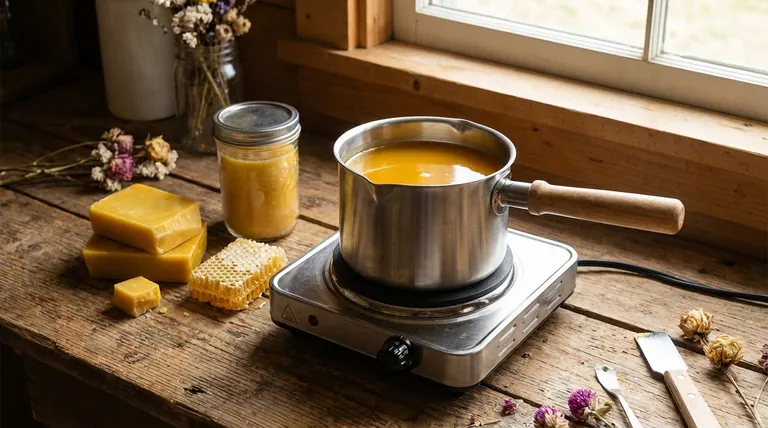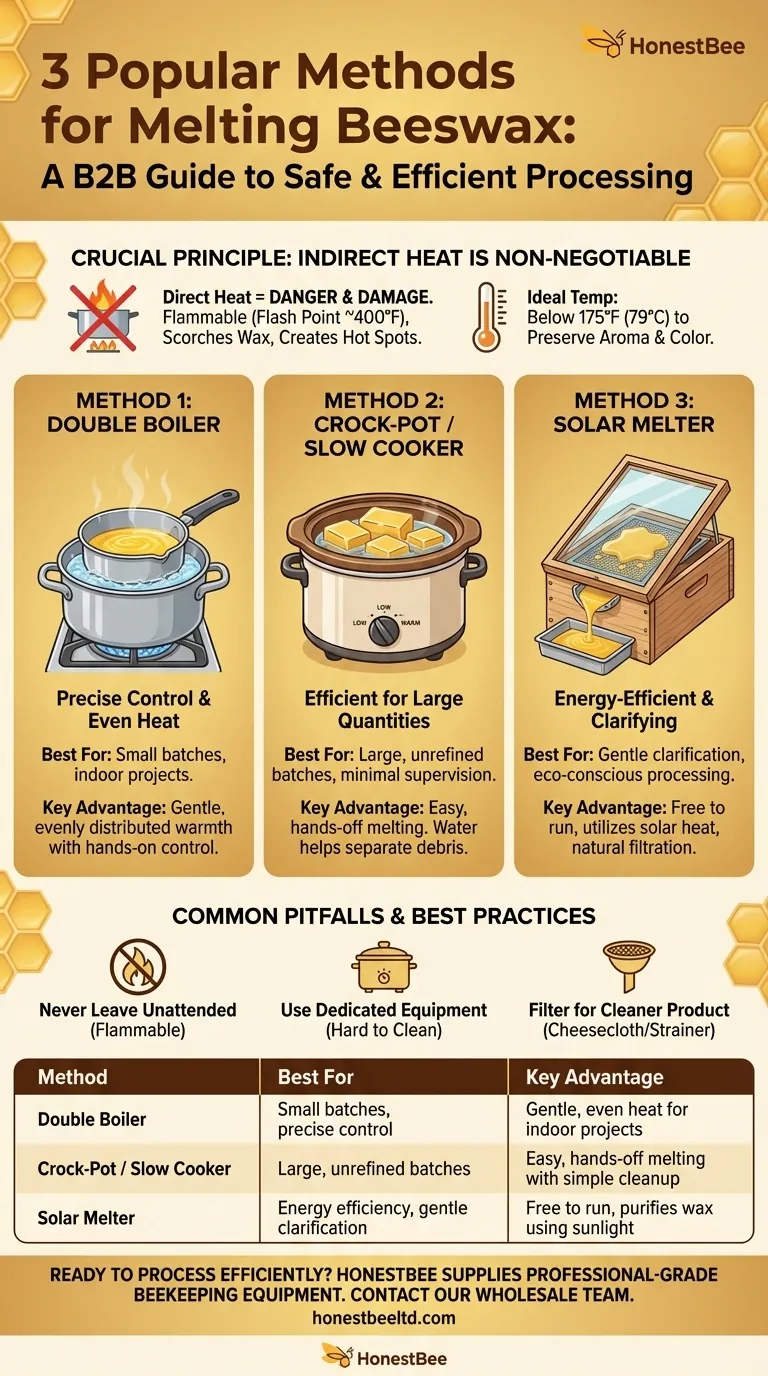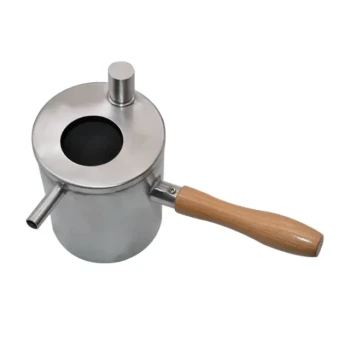The three most popular methods for melting beeswax are the double boiler, the crock-pot (or slow cooker), and the solar melter. Each method is favored because it provides the gentle, indirect heat necessary to melt the wax safely without scorching it or creating a fire hazard.
The core principle of melting beeswax is to avoid direct heat at all costs. Because beeswax is flammable and sensitive to high temperatures, using an indirect heat source like hot water or solar energy is essential to preserve its natural qualities and prevent a dangerous fire.

The Critical Principle: Why Indirect Heat is Non-Negotiable
Before exploring the methods, it's crucial to understand why you can't simply put beeswax in a pan over a flame. The properties of the wax itself dictate the entire process.
Understanding Beeswax's Flammability
Beeswax is a flammable material with a flash point around 400°F (204°C). When heated directly, it can easily overheat, flare up, and catch fire, creating a significant safety risk.
Preserving Wax Quality
High temperatures also degrade the quality of the wax. To retain beeswax's natural aroma, light color, and beneficial anti-microbial properties, it's best to keep the temperature below 175°F (79°C). Overheating can darken the wax and diminish its delicate scent.
The Problem with Direct Heat
Placing a pot of beeswax directly on a stove burner creates hot spots that far exceed safe temperatures. This leads to scorching, degradation of the wax, and a serious fire risk. Indirect heating methods solve this by providing gentle, evenly distributed warmth.
Exploring the Three Primary Melting Methods
Each of the three recommended methods uses the principle of indirect heat to ensure a safe and effective melt.
Method 1: The Double Boiler
The double boiler is a classic, controlled method for melting materials that are sensitive to heat. You can use a dedicated double boiler or create a makeshift one by placing a smaller pot or heat-proof bowl containing the wax inside a larger pot filled with a few inches of simmering water.
The water heats the inner container gently and evenly, giving you precise control over the melting process. This is an excellent method for smaller batches and indoor projects.
Method 2: The Crock-Pot or Slow Cooker
Using a crock-pot is ideal for melting larger quantities of beeswax with minimal active supervision. Simply place the raw beeswax in the cooker, set it to the "low" or "warm" setting, and allow it to melt slowly.
For raw, unfiltered comb, you can add water to the crock-pot along with the wax. As the wax melts and later cools, most debris will sink to the bottom or get trapped in the water layer, making initial cleaning much easier.
Method 3: The Solar Melter
A solar melter is the most energy-efficient and gentle method. It uses the sun's radiant heat to slowly melt the wax. A basic melter is an insulated box with a glass or plastic lid, positioned to catch direct sunlight.
The wax is placed inside, often on a screen or filter, and melts slowly, dripping into a collection pan below. This process is not only free to run but is also excellent for clarifying and cleaning wax, as debris is often left behind on the screen. Its primary limitation is its dependence on sunny weather.
Common Pitfalls and Best Practices
Regardless of the method you choose, adhering to a few key practices will ensure safety and a high-quality result.
Never Leave Melting Wax Unattended
This is the most important rule. Beeswax is flammable, and even with indirect heat, situations can change quickly. Always remain present and attentive throughout the melting process.
Use Dedicated Equipment
Beeswax is notoriously difficult to clean from pots, spoons, and containers. It is highly recommended to dedicate a set of inexpensive pots and utensils exclusively for your beeswax projects to avoid a frustrating cleanup.
Filter for a Cleaner Product
After the initial melt, your beeswax will likely contain honey, pollen, and other hive debris. Pouring the molten wax through several layers of cheesecloth or a fine-mesh strainer will produce a much cleaner, purer final product.
Making the Right Choice for Your Goal
The best method depends entirely on your specific needs, the amount of wax you have, and your available resources.
- If your primary focus is speed and control for smaller projects: The double boiler method offers the most hands-on control and is relatively quick.
- If your primary focus is processing large, unrefined batches with ease: A dedicated crock-pot is the most efficient and straightforward option.
- If your primary focus is energy efficiency and gentle clarification: The solar melter is an unbeatable, passive method for producing beautifully clean wax.
Ultimately, safely managing heat is the key to successfully working with this remarkable natural material.
Summary Table:
| Method | Best For | Key Advantage |
|---|---|---|
| Double Boiler | Small batches, precise control | Gentle, even heat for indoor projects |
| Crock-Pot / Slow Cooker | Large, unrefined batches | Easy, hands-off melting with simple cleanup |
| Solar Melter | Energy efficiency, gentle clarification | Free to run, purifies wax using sunlight |
Ready to process your beeswax efficiently and safely?
As a commercial beekeeper or distributor, your time and product quality are paramount. HONESTBEE supplies professional-grade beekeeping equipment and supplies designed for high-volume operations like yours. From durable wax melters to essential processing tools, we provide the reliable equipment you need to scale your production.
Contact our wholesale team today to discuss your specific needs and discover how our products can help you maximize efficiency and protect your valuable beeswax.
Visual Guide

Related Products
- Professional Stainless Steel Wax Melter for Beekeeping and Crafts
- Beeswax Melter for Candle Making Honey Bee Wax Melter
- Steam Beeswax Melter Wax Warmer for Wax Processing
- Electric Beeswax Flat Sheet Machine with Operating Tray for Wax Processing
- Electric Flatting and Embossing Machine with Tray for Beekeeping
People Also Ask
- What are the safety precautions when working with melted beeswax? Prevent Burns and Fire Hazards
- How long does the wax melting process typically take? A Guide to Safe & Efficient Melting
- What temperature range is considered gentle heat for melting beeswax? Preserve Aroma & Color
- What are the steps for using a wax melter to melt beeswax? Master Safe, Efficient Beeswax Processing
- How do you pour melted beeswax into a mold? A Step-by-Step Guide for a Flawless Finish



















